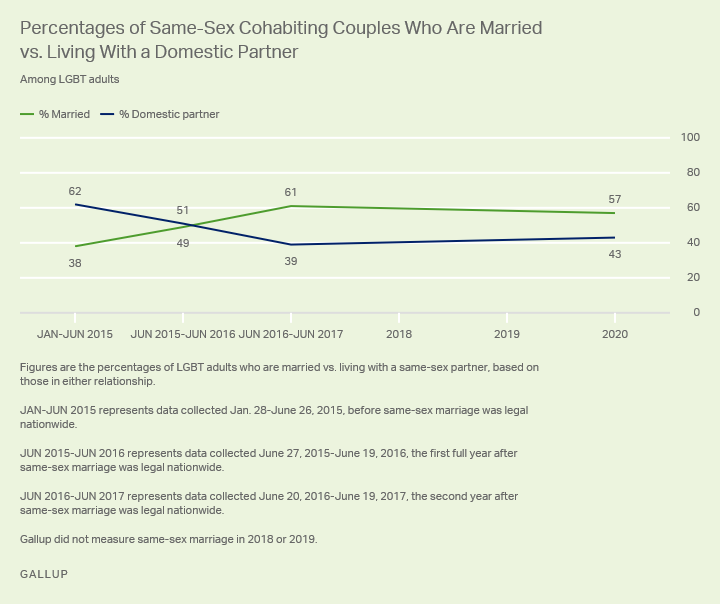Story Highlights
- 9.6% of LGBT adults in the U.S. are married to a same-sex spouse
- Number of same-sex marriages have increased since 2016
- Opposite-sex marriages, partnerships more common among bisexual adults
WASHINGTON, D.C. — About one in 10 LGBT adults in the U.S. (9.6%) are married to a same-sex spouse, with a slightly smaller proportion (7.1%) living with a same-sex domestic partner. Half of LGBT adults have never been married, while 11.4% are married to an opposite-sex spouse and 9.5% are either divorced or separated.
Overall, less than 1% of U.S. adults are married to a same-sex spouse. The greatest percentage of Americans, 47.7%, are married to an opposite-sex spouse.
U.S. Adults’ and LGBT Adults’ Marital Status
| U.S. adults | LGBT adults | ||||||||||||||||||||||||||||||||||||||||||||||||||||||||||||||||||||||||||||||||||||||||||||||||||
|---|---|---|---|---|---|---|---|---|---|---|---|---|---|---|---|---|---|---|---|---|---|---|---|---|---|---|---|---|---|---|---|---|---|---|---|---|---|---|---|---|---|---|---|---|---|---|---|---|---|---|---|---|---|---|---|---|---|---|---|---|---|---|---|---|---|---|---|---|---|---|---|---|---|---|---|---|---|---|---|---|---|---|---|---|---|---|---|---|---|---|---|---|---|---|---|---|---|---|---|
| % | % | ||||||||||||||||||||||||||||||||||||||||||||||||||||||||||||||||||||||||||||||||||||||||||||||||||
| Married to opposite-sex spouse | 47.7 | 11.4 | |||||||||||||||||||||||||||||||||||||||||||||||||||||||||||||||||||||||||||||||||||||||||||||||||
| Married to same-sex spouse | 0.6 | 9.6 | |||||||||||||||||||||||||||||||||||||||||||||||||||||||||||||||||||||||||||||||||||||||||||||||||
| Living with opposite-sex domestic partner | 8.1 | 9.2 | |||||||||||||||||||||||||||||||||||||||||||||||||||||||||||||||||||||||||||||||||||||||||||||||||
| Living with same-sex domestic partner | 0.4 | 7.1 | |||||||||||||||||||||||||||||||||||||||||||||||||||||||||||||||||||||||||||||||||||||||||||||||||
| Single/Never married | 22.9 | 50.5 | |||||||||||||||||||||||||||||||||||||||||||||||||||||||||||||||||||||||||||||||||||||||||||||||||
| Separated | 2.4 | 2.0 | |||||||||||||||||||||||||||||||||||||||||||||||||||||||||||||||||||||||||||||||||||||||||||||||||
| Divorced | 9.5 | 7.5 | |||||||||||||||||||||||||||||||||||||||||||||||||||||||||||||||||||||||||||||||||||||||||||||||||
| Widowed | 5.9 | 2.5 | |||||||||||||||||||||||||||||||||||||||||||||||||||||||||||||||||||||||||||||||||||||||||||||||||
| No opinion | 2.6 | 0.4 | |||||||||||||||||||||||||||||||||||||||||||||||||||||||||||||||||||||||||||||||||||||||||||||||||
| Based on aggregated data from 2020 Gallup polls | |||||||||||||||||||||||||||||||||||||||||||||||||||||||||||||||||||||||||||||||||||||||||||||||||||
| Gallup | |||||||||||||||||||||||||||||||||||||||||||||||||||||||||||||||||||||||||||||||||||||||||||||||||||
These results are based on aggregated data from 2020 Gallup surveys, encompassing interviews with more than 15,000 U.S. adults. According to Gallup’s latest estimate, 5.6% of U.S. adults identify as lesbian, gay, bisexual or transgender, with over half of them saying they are bisexual. LGBT identification is most prevalent among young adults, explaining the high proportion of the subgroup that has never been married.
The percentage of LGBT adults in same-sex marriages appears to have leveled off after increasing following the Supreme Court’s 2015 Obergefell v. Hodges decision that legalized same-sex marriages nationwide. In the six-month period before the Obergefell ruling, Gallup found that 7.9% of LGBT adults were in same-sex marriages. That percentage increased to 9.6% in the first year after the decision (through June 2016) and is the same in the 2020 average.
However, because of the growth in LGBT identification in recent years, coupled with the growth in the U.S. population more generally, the number of same-sex marriages has likely increased significantly. In the pre-Obergefell decision period, Gallup estimated that 0.3% of U.S. adults overall were married to a same-sex spouse. In the first year after that ruling, the proportion of U.S. adults in same-sex marriages was 0.4%, and is 0.6% today.
Extrapolating those percentages to the U.S. population suggests that an estimated 1.5 million U.S. adults are married to a same-sex spouse, which would translate to about 750,000 same-sex marriages. Previously, Gallup estimated there were 368,000 same-sex marriages before the Obergefell decision and 491,000 in the first 12 months after it.
Same-sex marriage rates are similar among most demographic subgroups of U.S. adults, although the percentage does exceed 1% among higher-socioeconomic-status Americans — those in upper-income households (annual incomes of $100,000 or more) and those with education beyond a four-year college degree. The percentage of people married to a same-sex spouse also exceeds 1% among political liberals, Democrats and those with no religious affiliation.
Additionally, Gallup trends show that same-sex cohabiting couples are increasingly opting for marriage rather than domestic partnership. In the months leading up to the nationwide legalization of same-sex marriage in 2015, many more LGBT Americans in same-sex cohabiting couples were living together but not married (62%) as opposed to being married (38%). In the first 12 months after same-sex marriages were legalized, the split was roughly even, with 49% being married and 51% not married. Since then, about six in 10 same-sex couples have been married, including 57% in the 2020 data.

Line graph. Proportion of same-sex cohabiting couples who are married versus domestic partners. From January to June 2015, before the Supreme Court ruled same-sex marriages were legal, 62% of same-sex cohabiting couples were domestic partnerships and 38% were married. In the first year after the Supreme Court ruling, 51% were domestic partnerships and 49% marriages. Since then, the majority of same-sex cohabiting couples have been marriages.
Same-Sex Committed Relationships Uncommon for Bisexual Adults
Notably, same-sex marriages are largely confined to gay, lesbian or transgender adults. Only 1.0% of bisexual adults — who comprise the largest segment of the LGBT population — report being married to a same-sex spouse. Meanwhile, 17.2% of bisexual adults are married to a spouse of the opposite sex, which explains why LGBT adults overall are somewhat more likely to be married to an opposite-sex spouse than to someone of the same gender.
Bisexual adults are also much less likely to have a same-sex domestic partner (2.7%) than to have an opposite-sex domestic partner (13.3%), which also leads to more LGBT adults in opposite-sex than same-sex domestic partnerships.
As might be expected, the patterns are different among gay and lesbian adults, who are much more likely to be in same-sex marriages and domestic partnerships than to be married to or in domestic partnerships with members of the opposite sex. Still, close to half of gay and lesbian adults identify their marital status as single.
Marital Status Among U.S. Adults Who Identify as Bisexual vs. Gay or Lesbian
| Bisexual adults | Gay/Lesbian adults | ||||||||||||||||||||||||||||||||||||||||||||||||||||||||||||||||||||||||||||||||||||||||||||||||||
|---|---|---|---|---|---|---|---|---|---|---|---|---|---|---|---|---|---|---|---|---|---|---|---|---|---|---|---|---|---|---|---|---|---|---|---|---|---|---|---|---|---|---|---|---|---|---|---|---|---|---|---|---|---|---|---|---|---|---|---|---|---|---|---|---|---|---|---|---|---|---|---|---|---|---|---|---|---|---|---|---|---|---|---|---|---|---|---|---|---|---|---|---|---|---|---|---|---|---|---|
| % | % | ||||||||||||||||||||||||||||||||||||||||||||||||||||||||||||||||||||||||||||||||||||||||||||||||||
| Married to opposite-sex spouse | 17.2 | 0.3 | |||||||||||||||||||||||||||||||||||||||||||||||||||||||||||||||||||||||||||||||||||||||||||||||||
| Married to same-sex spouse | 1.0 | 23.9 | |||||||||||||||||||||||||||||||||||||||||||||||||||||||||||||||||||||||||||||||||||||||||||||||||
| Living with opposite-sex domestic partner | 13.3 | 1.6 | |||||||||||||||||||||||||||||||||||||||||||||||||||||||||||||||||||||||||||||||||||||||||||||||||
| Living with same-sex domestic partner | 2.7 | 15.9 | |||||||||||||||||||||||||||||||||||||||||||||||||||||||||||||||||||||||||||||||||||||||||||||||||
| Single/Never married | 55.5 | 47.8 | |||||||||||||||||||||||||||||||||||||||||||||||||||||||||||||||||||||||||||||||||||||||||||||||||
| Separated | 1.0 | 1.3 | |||||||||||||||||||||||||||||||||||||||||||||||||||||||||||||||||||||||||||||||||||||||||||||||||
| Divorced | 8.0 | 6.1 | |||||||||||||||||||||||||||||||||||||||||||||||||||||||||||||||||||||||||||||||||||||||||||||||||
| Widowed | 1.4 | 1.9 | |||||||||||||||||||||||||||||||||||||||||||||||||||||||||||||||||||||||||||||||||||||||||||||||||
| No opinion | 0.0 | 1.0 | |||||||||||||||||||||||||||||||||||||||||||||||||||||||||||||||||||||||||||||||||||||||||||||||||
| Based on aggregated data from 2020 Gallup polls; Gallup does not have sufficient data to report reliable, separate estimates for gay vs. lesbian adults, or for transgender adults. | |||||||||||||||||||||||||||||||||||||||||||||||||||||||||||||||||||||||||||||||||||||||||||||||||||
| Gallup | |||||||||||||||||||||||||||||||||||||||||||||||||||||||||||||||||||||||||||||||||||||||||||||||||||
Gallup does not have sufficient data for transgender adults to yield reliable estimates of marital status among that group.
Bottom Line
Same-sex marriages are not common in the U.S., or even very common among LGBT adults. But they are becoming more prevalent in the U.S. because of the increase in the LGBT population more generally and because more same-sex cohabiting couples are opting to marry rather than be unmarried partners.
What is unclear is how marital rates among LGBT adults will change as the population grows older and many reach the age when they would want to be in a committed relationship. Though it has been more than five years since same-sex marriage became legal, LGBT adults aged 30 and older are much more likely than non-LGBT adults in the same age group to describe their marital status as single (27.5% vs. 10.9%, respectively).
But decisions about entering committed relationships will be coming at a time when societal trends and attitudes are moving away from marriage. The 48% of Americans who reported being married in 2020 is down from 55% less than a generation ago, in 2006. Additionally, fewer Americans today than in the recent past believe it is important that people be married if they have children together, or if they want to spend the rest of their lives together.
It is unclear what those attitudes are among LGBT Americans, but young adults, nonreligious people, Democrats and political liberals — the subgroups most likely to be LGBT — are among the least likely subgroups to see marriage as being relevant.
And while many LGBT adults may decide not to get married, Americans increasingly support their right to marry a same-sex partner if they choose to do so.
Learn more about how the Gallup Poll Social Series works.

